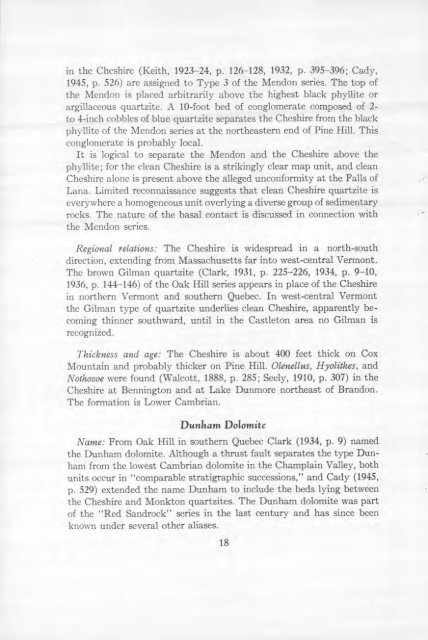STRATIGRAPHY AND STRUCTURE CASTLETON AREA VERMONT
STRATIGRAPHY AND STRUCTURE CASTLETON AREA VERMONT
STRATIGRAPHY AND STRUCTURE CASTLETON AREA VERMONT
You also want an ePaper? Increase the reach of your titles
YUMPU automatically turns print PDFs into web optimized ePapers that Google loves.
in the Cheshire (Keith, 1923-24, p. 126-128, 1932, P. 395-396; Cady,<br />
1945, P. 526) are assigned to Type 3 of the Mendon series. The top of<br />
the Mendon is placed arbitrarily above the highest black phyllite or<br />
argillaceous quartzite. A 10-foot bed of conglomerate composed of 2-<br />
to 4-inch cobbles of blue quartzite separates the Cheshire from the black<br />
phyllite of the Mendon series at the northeastern end of Pine Hill. This<br />
conglomerate is probably local.<br />
It is logical to separate the Mendon and the Cheshire above the<br />
phvllite; for the clean Cheshire is a strikingly clear map unit, and clean<br />
Cheshire alone is present above the alleged unconformity at the Falls of<br />
Lana. Limited reconnaissance suggests that clean Cheshire quartzite is<br />
everywhere a homogeneous unit overlying a diverse group of sedimentary<br />
rocks. The nature of the basal contact is discussed in connection with<br />
the Mendon series.<br />
Regional relations: The Cheshire is widespread in a north-south<br />
direction, extending from Massachusetts far into west-central Vermont.<br />
The brown Gilman quartzite (Clark, 1931, p. 225-226, 1934, P. 9-10,<br />
1936, p. 144-146) of the Oak Hill series appears in place of the Cheshire<br />
in northern Vermont and southern Quebec. In west-central Vermont<br />
the Gilman type of quartzite underlies clean Cheshire, apparently becoming<br />
thinner southward, until in the Castleton area no Gilman is<br />
recognized.<br />
Thickness and age: The Cheshire is about 400 feet thick on Cox<br />
Mountain and probably thicker on Pine Hill. Olenellus, Hyolithes, and<br />
Nothozoe were found (Walcott, 1888, P. 285; Seely, 1910, p. 307) in the<br />
Cheshire at Bennington and at Lake Dunmore northeast of Brandon.<br />
The formation is Lower Cambrian.<br />
Dunham Dolomite<br />
Name: From Oak Hill in southern Quebec Clark (1934, p. 9) named<br />
the Dunham dolomite. Although a thrust fault separates the type Dunham<br />
from the lowest Cambrian dolomite in the Champlain Valley, both<br />
units occur in "comparable stratigraphic successions," and Cady (1945,<br />
p. 529) extended the name Dunham to include the beds lying between<br />
the Cheshire and Monkton quartzites. The Dunham dolomite was part<br />
of the "Red Sandrock" series in the last century and has since been<br />
known under several other aliases.<br />
18













